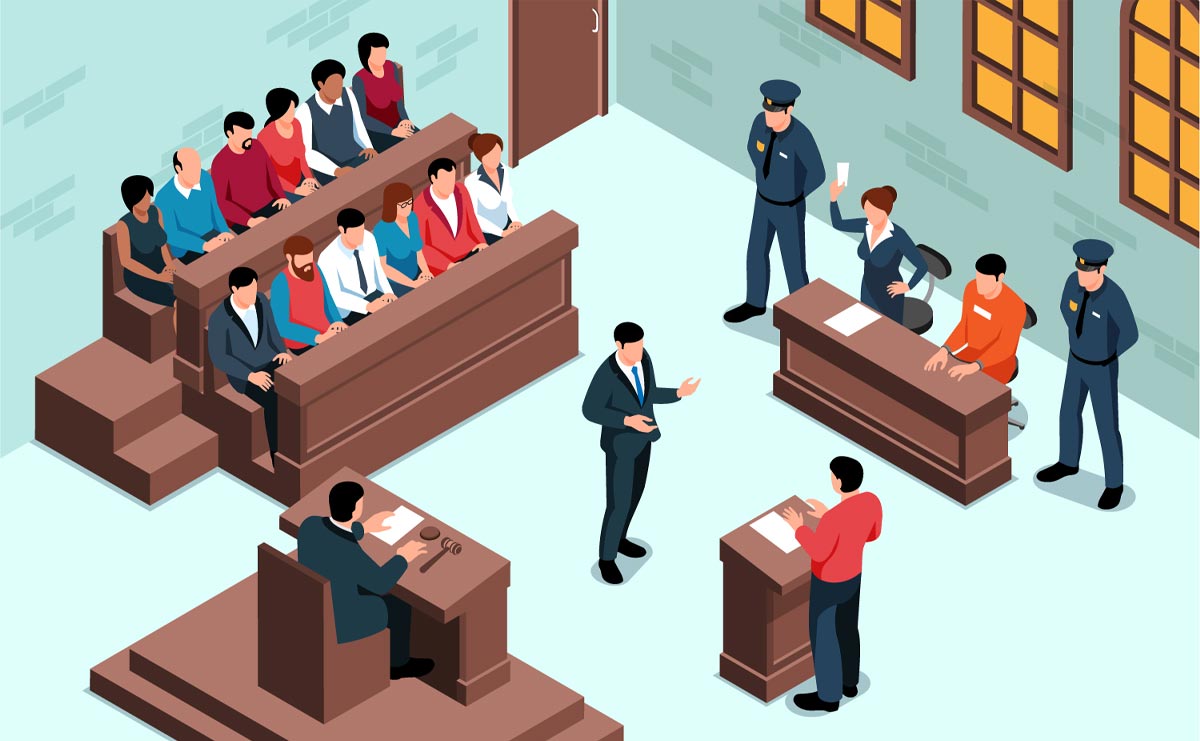Contents
Cross-Examination: Techniques and Strategies for Success in the Courtroom
Cross-examination is one of a lawyer’s most impactful tools in a trial. It is the moment when the attorney gets to directly challenge a witness’s testimony, uncover contradictions, and strengthen their client’s argument. To do it well, a lawyer needs solid strategy, thorough preparation, and the finesse to execute it effectively in the heat of the courtroom. To master courtroom skills, lawyers must learn how to do cross-examination in a way that carefully uncovers inconsistencies without alienating the jury. Some valuable cross-examination tips include asking concise questions, avoiding leading the witness to expand on answers unnecessarily, and always maintaining control of the narrative to highlight inconsistencies in testimony.
Understanding the Purpose of Cross-Examination
During the trial, it is essential to understand how to cross-examine a witness effectively, as this technique can expose inconsistencies in their testimony and strengthen your case. Cross-examiner tests the credibility, reliability, and truthfulness of witnesses. The purpose of an effective cross-examination is multi-faceted and plays a vital role in ensuring a fair and just trial. Here are the key purposes of cross-examination:
Challenging the Accuracy of Testimony: During cross-examination, the opposing party has the opportunity to question the witness on their direct testimony, seeking to identify inconsistencies, contradictions, or inaccuracies in their statements.
Assessing Credibility: The attorney can assess the credibility of the witness by asking probing questions. These may include questions about the witness’s motives, biases, or past behavior that could affect their reliability.
Revealing Omissions or Additional Facts: Cross-examination allows attorneys to explore areas that may have been left unaddressed during direct examination, filling in gaps and presenting additional facts that may be favorable to their case.
Exposing Bias or Interest: Attorneys may use cross-examination to demonstrate that the witness has a personal interest in the outcome of the case or holds biases that could influence their testimony.
Undermining the Opposing Party’s Case: Effective cross-examination can weaken the opposing party’s case by casting doubt on their key witnesses, which may influence the judge or jury’s final decision.
Confirming or Reinforcing Key Points: While cross-examination is often seen as a method of discrediting a witness, it can also extract information supporting the cross-examiner’s case, reinforcing critical points.
How to Develop a Winning Cross-Examination Strategy
Developing a winning cross-examination strategy requires thorough preparation, strategic planning, and a clear understanding of both the case and the witness. The first step is to identify your objectives. These may include exposing weaknesses in the witness’s testimony, supporting your case by extracting helpful information or undermining the witness’s credibility by revealing biases or inconsistencies. Having a clear idea of what you want to accomplish with each question you ask is important.
Preparation is not just a step it is the foundation of a successful and effective cross-examination. This includes reviewing depositions, prior statements, and other evidence related to the witness. Knowing exactly what the witness has said in the past can help you anticipate their answers during cross-examination. Predicting possible responses allows you to prepare counters or adjustments in your questioning, ensuring that you remain in control of the narrative.
During cross-examination, staying focused on the key points that will support your case or discredit the witness is essential. Refrain from getting sidetracked by irrelevant details that will not help you achieve your primary goals. Keep your questions short and direct to limit the witness’s ability to elaborate on their answers. By doing so, you maintain control over the conversation and prevent the witness from introducing information that could harm your case.
Leading questions are not just a tool, they are a powerful weapon in cross-examination because they allow you to control the flow of information. Leading questions on cross-examination are designed to elicit short, affirmative responses, allowing the attorney to maintain control over the narrative. By structuring your questions to prompt yes or no answers, you can guide the witness to provide responses that align with your strategy. This approach minimizes the risk of the witness delivering unpredictable or damaging answers, keeping you in charge of the exchange.
Body language and tone are also critical during cross-examination. Maintaining composure and professionalism will positively influence how the jury perceives your questioning. An overly aggressive or combative approach may turn the jury against you. Equally important is paying attention to the witness’s nonverbal cues. Signs of discomfort or hesitation can be indicators that your line of questioning is effective.
Finally, knowing when to stop is not just important, it is critical. Once you have made your point or extracted the necessary information, it is often best to stop before giving the witness a chance to recover or explain. Overreaching can backfire, so it is important to recognize when you have achieved your objective and move on.
Flexibility is another key element of a successful cross-examination strategy. Sometimes, a witness’s unexpected answer requires a quick pivot. Being adaptable in these situations allows you to adjust your strategy in real time and continue steering the testimony in a way that benefits your case. By following these principles, a well-executed cross-examination can weaken the opposing side and bolster your argument in court.
How To Write Cross-Examination Questions
Writing good cross-examination questions requires a clear strategy, focusing on controlling the narrative while discrediting the witness or extracting helpful information for your case. Here are key steps to consider when drafting cross-examination questions:
Stick to Leading Questions
Cross-examination questions should be leading, meaning they suggest the answer or only require a “yes” or “no” response. This keeps control of the conversation in your hands and prevents the witness from elaborating. Here are some cross examination examples:
- “You were not present at the scene, were you?”
- “You didn’t report the incident until two days later, correct?”
Focus on One Fact Per Question
Keep each question simple and direct, asking about only one fact at a time. This prevents confusion and ensures the jury or judge can easily follow along. Here are some cross-examination examples:
- “You spoke to the defendant on the phone that night, didn’t you?”
- “You didn’t see what happened before the accident, did you?”
Establish Inconsistencies
If the witness has made contradictory statements, use cross-examination to expose these inconsistencies. Start by establishing the initial statement and then reveal the contradiction:
- “Earlier, you testified that you saw the car run the red light. But in your deposition, you said you couldn’t see the traffic light, correct?”
Control the Tone
While maintaining a calm and professional demeanor, your tone should be firm, but not overly aggressive. Leading questions that feel like statements rather than genuine inquiries help maintain control of the witness’s answers.
Know When to Stop
Once the witness has given a damaging admission or agreed with a point that strengthens your case, move on. Avoid over-questioning and allow the witness to explain or recover.
Frame Questions Around Key Points
Focus on points that discredit the witness’s reliability, bias, or the accuracy of their testimony. For example, if you suspect bias:
- “You have been friends with the plaintiff for ten years, haven’t you?”
- “You never mentioned this information during the police investigation, correct?”
Use Impeachment Sparingly
Impeachment questions are used to directly attack the witness’s credibility. If you have strong evidence of a lie or misrepresentation, make sure to structure the question to expose this effectively:
- “In your deposition, you swore under oath that you did not see the accident, right?”
Common Cross-Examination Mistakes and How to Prevent Them
In cross-examination, avoiding common mistakes is crucial for maintaining credibility and achieving a favorable outcome. Here are some common cross-examination mistakes and tips on how to prevent them:
Overloading the Witness with Questions
Asking too many questions at a time can overwhelm the witness, resulting in more precise and consistent answers. To avoid this, focus on asking concise and clear questions that target specific points. This approach helps maintain clarity, allows you to control the narrative, and keeps your argument focused, preventing key points from being diluted.
Failing to Prepare Thoroughly
Entering cross-examination without a thorough understanding of the witness’s statements or evidence can result in missed opportunities or being blindsided by unexpected answers. To avoid this, preparing extensively by reviewing the witness’s prior testimony, written statements, and relevant evidence is crucial. This preparation allows you to identify weaknesses and inconsistencies, giving you the upper hand in effectively challenging the witness’s credibility.
Arguing with the Witness
Engaging in arguments with the witness can alienate the judge or jury, undermining your professionalism. To avoid this, maintain control and stay composed throughout the cross-examination. If the witness becomes argumentative, redirect the question and remain focused on your line of inquiry without becoming emotionally involved, ensuring you keep the proceedings on track.

Asking Open-Ended Questions
One of the primary tactics in cross-examination is using leading questions to challenge the credibility of the witness’s earlier testimony. Among the best cross-examination tips is to avoid asking open-ended questions, as they may allow the witness to provide damaging information. To avoid this, ask leading questions that require only yes/no answers or short, factual responses. Leading questions on cross-examination, such as “You signed the contract, didn’t you?” are critical in extracting admissions that might otherwise be avoided.
Losing Focus on the Goal
Pursuing irrelevant or tangential lines of questioning wastes time and weakens your argument. To avoid this, stick to a well-structured plan focusing on critical issues directly supporting your case or discrediting the witness’s credibility. By staying focused, you ensure that your cross-examination remains sharp and effective.
Failing to Listen
Focusing too much on your next question can cause you to miss key details in the witness’s current answer. Instead, actively listen to their responses, as they may present unexpected opportunities to challenge their credibility or clarify inconsistencies. You can make the most of these moments and strengthen your case by staying engaged.
Underestimating the Witness
Assuming a witness will be easy to handle without preparing for potential surprises can easily backfire. To avoid this, treat every witness seriously and anticipate possible defense strategies. Preparing counterarguments for even the smallest details ensures you are ready for unexpected developments and helps maintain control over cross-examination.
Being Too Aggressive or Confrontational
One of the most essential cross-examination tips is to remain calm and composed, even if the witness provides unexpected answers. A harsh or aggressive demeanor can alienate the jury and make the witness appear sympathetic. Instead, maintain a professional and respectful tone throughout the cross-examination. Let the facts discredit the witness, avoiding emotional tactics that could undermine your credibility and sway the jury against you.
By avoiding these mistakes and implementing disciplined strategies, you can maintain control of the cross-examination process and effectively dismantle the opposing witness’s credibility.
How to Deal with Expert Witnesses
When dealing with expert witnesses in cross-examination, preparation is critical to effectively challenging their testimony. Knowing how to cross-examine key witnesses is crucial for dismantling the opposing side’s case and creating doubt in the jury’s mind. Here are some strategies to consider:
Understand the Expert’s Qualifications and Biases: Know their background thoroughly and question their expertise in relation to the case. If they are biased or have financial incentives, expose these to weaken their credibility.
Focus on Methodology: Experts often base their conclusions on specific methodologies. Challenging these methods’ reliability, relevance, or application can undermine their findings.
Look for Inconsistencies: Review previous testimony, writings, or statements the expert may have made in other cases or publications. Point out contradictions to diminish their reliability.
Challenge Assumptions: Experts rely on assumptions to form opinions. If these assumptions are flawed or unrealistic, emphasize that their conclusions are shaky.
Simplify Complex Testimony: Experts might use technical jargon to make their opinions seem unimpeachable. Simplify their language during cross-examination to reveal weaknesses hidden behind the complexity.
Limit Their Scope: Establish boundaries on what the expert can testify to. Show that certain opinions may fall outside of their domain of expertise.
Control the Pace: Do not allow the expert to take over the questioning. Instead, ask closed-ended questions to keep answers concise and focused.
Use Hypotheticals: Presenting alternative hypothetical scenarios can highlight gaps in the expert’s conclusions or show that their opinion may not hold under different circumstances.
Cross-examining expert witnesses is about reducing their impact on the case, and these techniques can help you achieve that effectively.
Final Thoughts
Cross-examination is one of the most powerful tools in a lawyer’s arsenal. It is the moment where you can directly challenge a witness, expose inconsistencies, and strengthen your case. But to be effective, it requires more than just asking questions. It takes preparation, strategy, and the ability to read the courtroom in real time.
A great cross-examination can make or break a case. It is not just about catching a witness in a lie—it is about subtly undermining their credibility, challenging their version of events, and reinforcing the story you are telling the jury. The key is staying focused on your goals, asking the right questions, and knowing when to stop. Going too far can give the witness room to recover, so recognizing when you have made your point is crucial.
In the end, cross-examination is about controlling the narrative. With the right approach, it can turn the tide in your favor, but it requires practice, discipline, and a clear strategy to get it right.
RunSensible is an all-in-one business management platform designed to streamline operations for law firms and other service-oriented businesses. It offers tools, including CRM, billing, client intake, and workflow automation, to help firms manage their processes efficiently. By integrating various functions into one platform, RunSensible allows firms to improve productivity, enhance client communication, and drive growth, all while reducing administrative burdens. Whether managing cases, tracking leads, or optimizing financials, RunSensible provides the flexibility and power needed to stay ahead in a competitive industry.
Frequently Asked Questions
Why is cross-examination the sexiest part of a trial?
Cross-examination is often considered the “sexiest” part of a trial because it combines drama, tension, and skill dynamically. It is the moment when lawyers showcase their advocacy by challenging the credibility of witnesses, exposing contradictions, and sometimes eliciting surprising revelations, creating suspense and unpredictability. The psychological battle between the lawyer and witness and the high stakes of potentially shifting the case’s direction make it a gripping and tense experience. This phase highlights the lawyer’s strategy, wit, and control, adding to the excitement and intensity of the trial.
What type of cross-examination do you conduct?
In a cross-examination, the goal is to challenge the credibility of the opposing witness and weaken their testimony. There are generally two types of cross-examination: destructive and constructive. Destructive cross-examination aims to discredit the witness by exposing inconsistencies, contradictions, or biases, making their testimony less reliable. This approach focuses on highlighting prior conflicting statements, demonstrating biases, or questioning the witness’s knowledge and expertise. On the other hand, constructive cross-examination seeks to use the witness’s testimony to support the cross-examiner’s case. Rather than undermining the witness, this method draws out helpful information by focusing on points of agreement and asking leading questions that guide the witness toward admissions that reinforce the cross-examiner’s argument. An effective cross-examination often involves a combination of both approaches, tailored to the strengths and weaknesses of the witness.
How to cross-examine a liar?
Cross-examining a liar requires careful strategy and a composed approach. Start by thoroughly preparing, understanding the facts of the case, and gathering the witness’s background to catch inconsistencies. Use short, leading questions that limit the witness’s ability to fabricate additional details and isolate the lies by breaking down their story into small, manageable parts. Introduce prior statements or contradictory evidence to trap the witness in their falsehoods. Stay calm and in control, even if the witness becomes defensive, and observe their body language for signs of discomfort. Highlight the implausibility of their testimony with questions that focus on logic and common sense. Patience is key—allow the liar enough space to contradict themselves and expose the truth
This article will provide an in-depth exploration of the key strategies that lawyers can use to conduct effective cross-examinations. It will cover the importance of preparation, the use of leading questions, and how to control the narrative during questioning. The article will also address common pitfalls, such as being overly aggressive or losing focus, and offer practical tips on avoiding these mistakes. Also, it will discuss how to handle expert witnesses, ensuring that their testimony is carefully scrutinized to limit their impact. Ultimately, the content will equip lawyers with actionable techniques to succeed in cross-examinations, positioning them to challenge witness credibility and strengthen their case in court.
Disclaimer: The content provided on this blog is for informational purposes only and does not constitute legal, financial, or professional advice.







